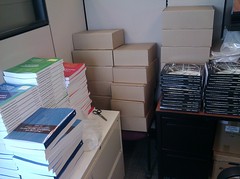| (Photo credit: Wikipedia) |
Introduced by Senate President pro Tem Darrell Steinberg (D-Sacramento), SB 1052 provides for the selection, development and administration of free open digital textbooks for the most popular lower-division courses and overseen by the establishment of the "California Open Education Resources Council" (COERC). COERC, established by the legislation, will be comprised of faculty members from the University of California, California State University and Community Colleges to determine which courses merit inclusion. Its companion bill, SB 1053, creates the California Open Source Digital Library to house the open source textbooks and courseware.
Both bills place California first in the nation among states to combat higher education's growing price tag with open source software and Creative Commons open licenses so that students can access sophisticated tools and college-level information at no or low cost, allowing them to mitigate escalating college fee increases and save their money for student housing.
With the Governor's signature, California is set to create a competitive "Request for Proposals" (RFP) process inviting faculty, publishers, and others to develop high quality digital open source textbooks and related courseware. The materials will be placed under a "Creative Commons" licensing structure that allows students and faculty free access, and allows instructors to create customized materials from these textbooks and other courseware. Materials must also meet the rigorous standards of college core curricula, and will be reviewed and approved by subject matter experts. "This is a great victory for students and middle class families struggling with the ever-increasing costs of higher education," said Steinberg. "This is a major step toward using technology to cut costs for students while enhancing the quality of higher education in California."
"At a time when the cost of attending California's public colleges and universities is skyrocketing, Governor Jerry Brown recognized that by embracing our digital future with innovative technological advancements like open source textbooks we can save college students in California millions of dollars in escalating book costs," said 20 Million Minds Foundation President Dean Florez. The foundation has been supportive of policy measures to create quality open source textbooks for college students throughout the nation. "This is the first time government has come in with substantial dollars that match philanthropic efforts to create a library where students can access free textbooks and faculty can utilize their skills to remix, revise, and repurpose these textbooks for their students."
Funding for the bills also signed by the governor (SB 1028), appropriates five million dollars for the project from the state public college savings plan ScholarShare Trust fund to be matched by private entities and philanthropy.
Dr. Larry Green, Mathematics Co-Chair of Lake Tahoe Community College, who has been utilizing a free open source textbook for his students, praised the governor. "From the instructors' perspective, having access to a wealth of professional course materials to edit, use and share frees up time for pursuing more one-on-one interaction with students and more personalized learning," said Green. "Choosing to adopt an enhanced digital open textbook for my students spares them several thousands of dollars in combined textbook expenses and increases student success. I thank the Governor for recognizing the need to provide faculty with the tools necessary for remixing curriculum while preserving academic freedom by providing free quality textbook choices for college professors and their students."
The open source library will allow students to download textbooks for free or pay around $20 for a hard copy, and was the principle reason the signed bills received approval by the University of California.
SOURCE The 20 Million Minds Foundation







